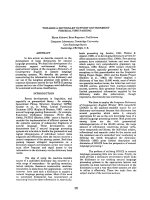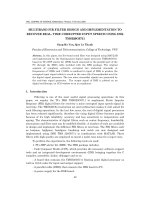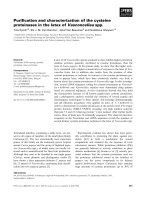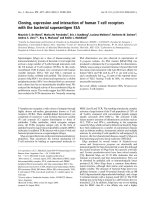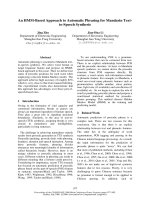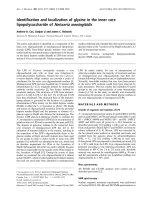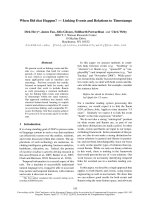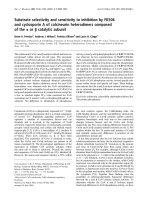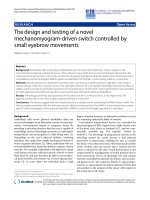Báo cáo " Multiband fiR Filter Design and implementation to recover real- time corrupted input speech using dsk tms320c6711 " ppt
Bạn đang xem bản rút gọn của tài liệu. Xem và tải ngay bản đầy đủ của tài liệu tại đây (267.16 KB, 8 trang )
VNU. JOURNAL OF SCIENCE, Mathematics - Physics, T.xXI, n
0
4, 2005
40
Multiband fiR Filter Design and implementation to
recover real- time corrupted input speech using dsk
tms320c6711
Sung Ho Van, Que Le Thanh
Faculty of Electronics and Telecommunication, College of Technology, VNU
Abstrac. In this paper, the five-band notch filter was designed using MATLAB
and implemented by the floating-point digital signal processor TMS320C6711
based on TI's DSP starter kit (DSK) board connected to the parallel port of the
PC through the DB25 cable included with the DSK package. The original
segment of symphony orchestra corrupted two undesired sinusoids at
frequencies of 750Hz and 1750Hz is conduced to input of DSK to produce the
corrupted input signal which is saved in the wave file (Corrupthandel.wav) for
the digital signal processor. The two noise sinusoidal signals are generated by
the real-time signal generator. The output signal of DSK is plotted on an
digital oscilloscope, on CCS window or on an earphones.
1. Introduction
Filtering is one of the most useful signal processing operations. In this
paper, we employ the TI's DSK TMS320C6711 to implement Finite Impulse
Response (FIR) digital filters for recovery a noise corrupted input speech-signal in
real time. The TMS320C6x instruction set and architecture makes it well suited for
such filtering operations. In the last few years, the cost of digital signal processors
has been reduced significantly, therefore the using digital filters becomes popular
because of it's high reliability, accuracy and less sensitivity to temperature and
ageing. The characteristics of digital filters such as center frequency, bandwidth,
attenuation and filter type can be modified flexibly. A number of tools are available
to design and implement the different FIR filters in real time. The FIR filters such
as lowpass, highpass; bandpass, bandstop and notch are now designed and
implemented using DSK TMS 320C6711 in combination with MATLAB. These
filters with high quality are employed to cancel a multi-tone noise for a input voice.
To perform the experiments, the following tools are used:
1. TI's DSP starter kit (DSK). The DSK package includes:
- Code Composer Studio (CCS), which provides the necessary software support
tools and an integrated development environment (IDE) bringing together the C
compiler, assembler, linker, debugger and so on.
- A board that contains the TMS320C6711 floating point digital processor as
well as 16-bit codec for input and output support.
- A parallel cable (DB25) that connects the DSK board to PC.
- A power supply for the DSK board.
Multiband FIR Filter Design and Implementation to
41
2. A Pentum compatible PC.
3. A digital oscilloscope, signal generator and earphones. Shareware utilities
are available that utilize the PC and sound card to create a virtual instrument such
as an oscilloscope, a function generator or a spectrum analyzer.
2. FIR filter structures
The input-output relationship of a N-order causal FIR digital filter is
described the following difference equation
y[n] =
0
[]
N
i
i
bxn i
=
−
∑
(1)
where b
i
, i = 0, 1, 2, …, N are the constant coefficients and just as the impulse
response h[i] of this FIR filter. The filter design with the desired frequency
response consists of the determining these coefficients b
i
. In other words, N+1
values of impulse response should be determined. The difference equation (1) is a
convolution between N+1 input samples x[n] and N+1 samples of a impulse
response h[i] as
, 0,1, ,
[]
0,
i
bi N
hi
other values
=
=
(2)
The direct form structure of the difference equation (1) is plotted in the
figure 1. This structure requires N+1 multipliers, N two-input adders and N unit-
delays for implementation. The difference equation (1) shows that the value of one
output sample at time n can be determined with knowledge of the N+1 values of
input signal included the present input x[n] and N values of the past inputs x[n-i].
Thus, the FIR filters are called transversal or tapped-delay filters.
If its impulse response h[n] is either symmetric, i.e.
h[n] = h[N-1], 0
≤ n ≤ N, (3)
or is antisymmetric, i.e.,
h[n] = - h[N-1], 0
≤ n ≤ N, (3)
then the FIR filter has a linear phase. Sine the order of a filter can be either even
or odd; it can define four types of symmetry for the impulse response. Figure2 and 3
is plot of linear- phase FIR structures with N even and odd. It should be noted that
the linear- phase FIR structures reduces a half of multipliers in comparison with
the direct form realization of the original FIR filter.
x[n]
h[0] h[1] h[2] h[N-1] h[N]
y[n]
z
-1
z
-1
z
-1
Sung Ho Van, Que Le Thanh
42
Figure1. Signal flow graph of direct form structure of a FIR filter.
If the order N is even and it's impulse response is symmetric, then the filter is
called type 1 linear phase FIR filter. In the general case for the type 1 FIR filters,
the frequency response is of the form
H
1
(e
j
ω
) = |H
1
(e
j
ω
)|.e
-jN
ω
/2
(5)
where the amplitude response is given by
|H
1
(e
j
ω
)| = | h
/2
1
2cos()
22
N
n
NN
h
nn
=
+−ω
∑
| (6)
If the order N is odd and the impulse response is symmetric, then the filter is
called type 2 linear phase FIR filter. In the general case for the type 2 FIR filters,
the frequency response is of the form
H
2
(e
j
ω
) = |H
2
(e
j
ω
)|.e
-jN
ω
/2
(7)
where the amplitude response is given by
|H
2
(e
j
ω
)| =
(1)/2
1
11
2cos()
22
N
n
N
hnn
+
=
+
−−ω
∑
(8)
Figure2. Signal flow graph of the sixth-order linear-phase FIR filter.
Figure3. Signal flow graph of the fifth-order linear-phase FIR filter.
If the order N is even and the impulse response is antisymmetric, then the
filter is called type 3 linear phase FIR filter. In the general case for the type 3 FIR
filters, the frequency response is of the form
H
3
(e
j
ω
) = |H
3
(e
j
ω
)|.e
-j(N
ω
/2-
π
/2)
, (9)
x
[n]
z
-1
z
-1
z
-
1
y[n]
z
-
1
z
-1
h[2]
h[1]
h[0]
y[n]
z
-1
z
-1
z
-1
z
-1
z
-1
z
-1
h[0]
h[1]
h[2]
x
[
n
]
h[3]
Multiband FIR Filter Design and Implementation to
43
where the amplitude response is given by
|H
3
(e
j
ω
)| =
/2
1
2[ ]sin()
2
N
n
N
h
nn
=
−ω
∑
(10)
h[N/2] = 0
If the order N is odd and the impulse response is antisymmetric, then the
filter is called type 4 linear phase FIR filter. In the general case for the type 4 FIR
filters, the frequency response is of the form
H
4
(e
j
ω
) = |H
4
(e
j
ω
)|.e
-j(N
ω
/2-
π
/2)
(11)
where the amplitude response is given by
|H
4
(e
j
ω
)| =
(1)/2
1
11
2[ ]sin()
22
N
n
N
hnn
+
=
+
−−ω
∑
(12)
The FIR type 3 and 4 are the basis to design and implement the ideal digital
differentiators or the Hilbert transforms.
An FIR filter with a frequency response that is a real function is often called a
zero-phase filter. Such a filter must have a noncausal impulse response.
3. Multiband FIR filter design
The digital filters can be designed by using many MATLAB functions. Here,
the MATLAB function remez uses the Parks-McClellan algorithm based on the
Remez exchange algorithm and Chebyschev's approximation theory and the Kaiser -
window function. The desired filter is the five-band notch filter with the center
frequencies of 808 Hz and 1800Hz. In this design, the normalized frequency defined
as 2f/F, where F is the sampling frequency (F = 8000Hz). This notch filter with two
stopbands represented by a total of five bands: the first passband has normalized
frequencies between 0 and 0.17 (0 and 680Hz) with corresponding magnitude of 1;
the second band is the first stopband, which has normalized frequencies between
0.175 and 0.18 (700 to 720Hz), with a corresponding magnitude of 0; the second
stopband has normalized frequencies between 0.395 and 0.4 (1580 to 1600Hz). The
stopbands and passbands of this 88
th
order five-band notch filter are summarized on
the following table 1.
Table 1. Specification of the five-band FIR notch filter
Band Normalized
frequency 2f/F
Frequency (Hz) Magnitude
1 0 – 0.17 0 - 680 1
2 0.175 - 0.18 700 - 720 0
3 0.185 - 0.385 740 - 1540 1
4 0.395 - 0.4 1580 - 1600 0
Sung Ho Van, Que Le Thanh
44
0.405 - 1 1620-4000 1
The figure 4 plotted the magnitude response and impulse response of the
designed five-band notch filter. This program generated a set of 89 coefficients
saved into the coefficient file matnoch89.cof in ASCII format. This coefficient file
uses a float data format and is shown in the following table 2.
Table 2. Coefficients of the 88th-order five-band notch filter
Float h[n]=
{-0.1329 0.0859 0.0099 0.0082 0.0565 0.0844 0.0553 -0.0002 -0.0265 -0.0060 0.0276
0.0322 0.0048 -0.0205 -0.0146 0.0132 0.0296 0.0165 -0.0090 -0.0184 -0.0052 0.0099
0.0076 -0.0075 -0.0141 -0.0029 0.0131 0.0154 0.0035 -0.0070 -0.0050 0.0026 0.0029 -
0.0057 -0.0112 -0.0052 0.0059 0.0097 0.0042 -0.0011 0.0007 0.0051 0.0026 -0.0060
0.9888 -0.0060 0.0026 0.0051 0.0007 -0.0011 0.0042 0.0097 0.0059 -0.0052 -0.0112 -
0.0057 0.0029 0.0026 -0.0050 -0.0070 0.0035 0.0154 0.0131 -0.0029 -0.0141 -0.0075
0.0076 0.0099 -0.0052 -0.0184 -0.0090 0.0165 0.0296 0.0132 -0.0146 -0.0205 0.0048
0.0322 0.0276 -0.0060 -0.0265 -0.0002 0.0553 0.0844 0.0565 0.0082 0.0099 0.0859
-0.1329}.
Figure 4.Magnitude response and impulse response
of the 88-order five-band notch filter.
The multiband notch filters can be implemented by making in cascade many
notch filters centered at different frequencies. In this method, a buffer is employed
for the delay samples of each filter. The output of the first notch filter becomes the
input to second notch filter, centered at adjoining frequency, and so on. The output
of final notch filter is also the output of an overall multiband notch filter. Figure 5
shows the ideal impulse response, designed impulse response, the Kaiser-window
and the magnitude response of the two FIR notch filters implemented by using the
Kaiser-window function to truncate the impulse response of an ideal FIR filter. The
β parameter of the Kaiser window is equal to 5.6533.
Multiband FIR Filter Design and Implementation to
45
From the magnitude plot in figure5, we observe that the minimum stopband
attenuation is smaller than 60 dB. The first notch filter centered at normalized
frequency of 0.202 (808Hz) containing 89 coefficients. The output of this filter is the
input to second notch filter centered at normalized frequency of 0.428 (1720Hz). The
coefficients of these two notch filters are saved in two coefficients file, notch1.cof
and notch2.cof, respectively.
Figure 5. Ideal and designed impulse response and magnitude response of five-
band notch filter designed using MATLAB with Kaiser window.
4. Multiband FIR implementation to recover corrupted input speech on
DSK TMS320C6711
The five-band FIR filter is designed scarcely above linked to DSK
TMS320C6711 to remove two undesired sinusoidal signals corrupting an input
speech signal. In these studies, the input speech signal is a segment of symphony
orchestra which is saved in the wave file (Handel.wav). This original segment of
symphony orchestra was added with two undesired sinusoidal at frequencies of
750Hz and 1750Hz to produce the corrupted in put signal which is saved also in the
wave file (Corrupthandel.wav) for the digital signal processor. The two noise
sinusoidal signals are generated by the real-time low frequency generator.
To recover the original segment of symphony orchestra using TMS320C6711,
the program MULTINOTCH.C is written, which implement the five-band notch
filter with the coefficient file fivenotch89.cof listing in the table 2. This five- band
notch filter is equivalent to two notch filters, each containing 89 coefficients and
designed with MATLAB, centered at 750Hz and 1750Hz, respectively. The buffer
dly[n] is used for the delay samples of notch filter.
The corrupted input signal, the recovered output signal and the amplitude
response of five band notch filter can be obtained on the digital oscilloscope or on
the CCS window of TMS320C6711. The size of input and output signals can be
regulated by using a GEL file. Change the positions of the slider in program, we can
observe the corrupted signal, the recovered signal at DSK output and it's spectrum
as shown in the figure 6 and 7.
Sung Ho Van, Que Le Thanh
46
Figure 6. Input corrupted symphony orchestra and it's spectrum obtained on
the virtual Instrument of Goldwave software.
Figure 6. Output filtered symphony orchestra and it's spectrum obtained on the
virtual instrument of Goldwave software.
Multiband FIR Filter Design and Implementation to
47
5. Conclusion
Multiband FIR notch filters are designed and implemented to remove two or
many undesired sinusoidal noise signals corrupting an arbitrary input voice signal.
The stopband and the center cut-off frequencies of these filters can be adjusted by
the access instructions in the operation C program of the TMS320C6711 floating -
point digital signal processor. It is more convenient to implement multiband FIR
notch filters by using C program calling ASM function. The resulted
implementation would have faster operating speed. This problem will be reported in
another paper.
References
1. Hồ Văn Sung, Xử lý số tín hiệu, T1&2, Phơng pháp truyền thống kết hợp
với phần mềm MATLAB, NXB Giáo Dục, Hà Nội 2003.
2.
Hồ Văn Sung, Thực hành xử lý số tín hiệu trên máy tính PC với MATLAB,
NXB Khoa học và Kỹ thuật, Hà Nội 2005.
3.
TMS320C6000 CPU and Instruction Set Reference Guide, SPRU189F, Texas
Instruments, Dallas, TX, 2000.
4.
G. Pallot, Processeurs de signaux et logique programmable, cours et TP
CNAM/MEDIAS 2002
5.
S.K. Mitra, Digital Signal Processing : A computer - Based Approach,
McGraw-Hill IRwin , 2001.
6.
S. K. Oppenhaim and at.all: Discrete-time Signal Processing, Prentice Hall,
1999.
7.
D.J.DeFatta, J.G.Lucas and W.S. Hodgkiss, Digital Signal Processing: A
System Design Approach, Wiley, New York NY 1988.
8. R. Chassaing, DSP Applications using C and the TMS320C6X DSK, John
Wiley & Sons , INC. 2002.
9. James H.McClellan, C. Sidney Burrus and at.all. Computer - Based Exercises
for Signal Processing Using MATLAB 5, Prentice Hall, 1998.
10.
TMS320C6000 Code Composer Studio Tutorial, SPRU301C, Texas
Instruments, Dallas, TX, 2001.
